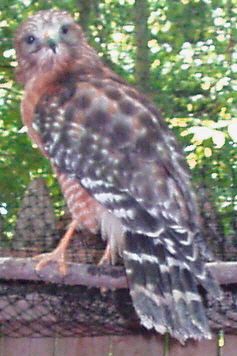We are not a large facility. Initially we took in mammals and birds and our yearly intake was about a hundred animals a year. Then we began to specialize, not out of choice but consequence. There are not many bird rehabilitators. Consequently we took in more birds than mammals and became more experienced with birds. Each species has specific dietary and housing needs. Large flight cages were constructed to properly care for raptors, large birds and waterfowl. As not all rehabilitators have large flight cages, other rehabilitators that did not have proper housing brought their large birds here for proper pre-release conditioning. Over time we dealt with more and more raptors. Now we are primarily a raptor (hawks, owls, eagles, accipiters and vultures) center specializing in owls, although we do take in other wildlife.
Being a small facility has its advantages. The primary focus is on the rehabilitation of the wildlife in our care. Striving to create as stress free of an environment as possible is an utmost concern. Stress can be fatal to wildlife. Non-veterinary medical care, feed and housing maintenance are provided by the same caregiver.
To help minimize stress even more, clothes and shoes worn by the caregiver are kept in the same color range. This familiararity helps maintain a stress reduced environment and also helps to prevent habituation towards humans.
Wildlife rehabilitation requires a permit from the Department of Environmental Protection , in addition, to handle migratory birds a permit from the United States Fish and Wildlife Service is required. A requirement of the USFW permit is that wildlife is kept apart from domesticity, i.e., humans and pets. For that reason our facility is not accessible to the public. The outdoor housing is nestled in the woods behind an eight foot stockade fence. Neither do we have wildlife for display nor education purposes. That cuts down on insurance costs so that money can be spent directly on the wildlife in for rehab. It also allows us to follow our consciences to avoid the stress wild birds and animals inevitably endure when kept for public viewing.
